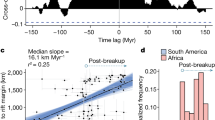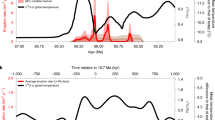Abstract
As hot, basaltic magma rises in a newly opened dyke during an eruption, it flows through colder crustal rock. The flowing magma advects heat along the dyke; at the same time, heat is conducted out of the dyke into the colder surroundings. The loss of heat will lead initially to the channel becoming constricted by magma solidifying against the walls. The channel may then become completely blocked, which will end the eruption at that site before the supply of magma is exhausted. Alternatively, the continual supply of heat by the flowing magma may, after some time, exceed the losses into the country rock. In this case, the initial solidification is reversed, the walls of the channel are progressively melted and the dyke is widened until the supply diminishes. We present here a model that quantitatively delineates these two regimes. We also identify an intermediate regime in which parts of the surface fissure may become blocked and the eruption continues from isolated vents.
This is a preview of subscription content, access via your institution
Access options
Subscribe to this journal
Receive 51 print issues and online access
$199.00 per year
only $3.90 per issue
Buy this article
- Purchase on Springer Link
- Instant access to full article PDF
Prices may be subject to local taxes which are calculated during checkout
Similar content being viewed by others
References
Macdonald, G. A. & Abbot, A. T. Volcanoes in the Sea. (University of Hawaii Press. Honolulu 1970).
Richter, D. H., Eaton, J. P., Murata, K. J., Ault, W. A. & Krivoy, H. L. U.S. Geol. Sun. Prof. Pap. 537-E (1970).
Thorarinsson, S., Steinthorsson, S., Einarsson, T. H., Kristmannsdottir, H. & Oskarsson, N. Nature 241, 372–375 (1973).
Thorarinsson, S. Bull. Vol. 33, 910–929 (1969).
Jaeger, J. C. Basalts. The Poldervaart Treatise on Rocks of Basaltic Composition (eds Hess, H. H. & Poldervaart, A.) 503–536 (Interscience, New York, 1968).
Spence, D. A. & Turcotte, D. L. J. geophys. Res. 90, 575–580 (1985).
Lister, J. R. J. Fluid Mech. 210, 263–280 (1990).
Delaney, P. T. & Pollard, D. D. Am. J. Sci. 282, 856–885 (1982).
Delaney, P. T. & Pollard, D. D. U.S. Geol. S. Prof. Pap. 1202 (1981).
Bruce, P. M. thesis. Univ. of Cambridge (1989).
Bruce, P. M. & Huppert, H. E. in Magma Transport and Storage (ed. Ryan, M. P.) (Wiley, London, in the press).
Huppert, H. E. & Sparks, R. S. J. Contr. Miner. Petrol. 75, 279–289 (1980).
Wilson, L. & Head, J. W. J. geophys. Res. 86, 2971–3001 (1981).
Anderson, I. New Scientist 1567, 50–54 (1987).
McBirney, A. R. Igneous Petrology. (Freeman-Cooper, San Francisco, 1984).
Author information
Authors and Affiliations
Rights and permissions
About this article
Cite this article
Bruce, P., Huppert, H. Thermal control of basaltic fissure eruptions. Nature 342, 665–667 (1989). https://doi.org/10.1038/342665a0
Received:
Accepted:
Issue Date:
DOI: https://doi.org/10.1038/342665a0
Comments
By submitting a comment you agree to abide by our Terms and Community Guidelines. If you find something abusive or that does not comply with our terms or guidelines please flag it as inappropriate.



